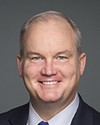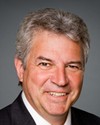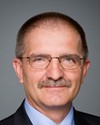I will start in French.
The committee established by the Minister of Veterans Affairs in December 2011 is made up of five individuals who were given the mandate to study one issue: depleted uranium. I could read you the mandate we were given, but it is in the report.
Essentially, the mandate comes down to two questions: is depleted uranium harmful to human health? Could Canadian soldiers have been exposed to depleted uranium? The two questions are linked, because there must be exposure in order for there to be an effect on health. It is very important to understand that. There was a very close and very important link between the two parts of the mandate.
I will start with exposure. I will continue in English.
Uranium, I'm not saying depleted uranium, but uranium is ubiquitous. By this I mean it's all over. It's in the earth's crust. We all have some one way or the other. We all have some uranium in our bodies at levels that can be measured. It comes from various natural sources. It's in our food, in our water to variable degrees. The amount that you have in your body varies from place to place geographically.
It's important to remember this: soldiers on the battleground do not have any individual monitors that can measure if they have been exposed to depleted uranium at a moment in time. Why? It doesn't exist. The technology is not there. It's not just Canada, no country has that, that I'm aware of. That makes it a bit more difficult to establish exposure, so this has to be done in a more indirect way. So you look at the situations, the broader context, and a few facts.
Canada does not use depleted uranium, so we do not have depleted uranium rounds. The Canadian soldiers in the conflicts that they were involved in, their enemy did not have depleted uranium weapons, so they were not fired upon directly by depleted uranium rounds. Also, there was no incident, that we're aware of, of any friendly fire by friendly troops, namely the Americans or the British, by accident on Canadian troops.
Let's look at the theatres where the Canadians were, as another general way of looking at exposure.
When depleted uranium weapons were first used was during the Gulf War in 1991. Canada did not deploy ground combat troops to that conflict. They deployed air and naval elements, and also a field hospital that was well behind the battle lines. There was one exception, however, and this was shortly after the war. There was a group of combat engineers who were co-located with American troops in a place called Doha, and there was an accidental fire—it was not an act of war or anything—and some of the depleted uranium rounds that the Americans used, which they used quite a bit in the Gulf War, were caught in the fire. There was no explosion per se, but the depleted uranium was present. Some of it was burnt and some particles were created, which were liberated in the area. We might come back to Doha later on, but that is really the only documented case.
I'll say it right now—and incidentally I'm jumping ahead of myself—but this was thoroughly investigated and it was determined that there was no appreciable risk to the health of these veterans.
Urinalysis is another way of finding out if there has been exposure. This is an individual measurement not a group measurement. The principle behind it is that uranium as well as depleted uranium, because both are related, are found in urine. In fact, any uranium or depleted uranium that is ingested or inhaled is going to end up being excreted in the urine. That is where it goes, nowhere else. That being the case, urinalysis can determine if uranium or depleted uranium is present.
Several countries, including Canada, have used these methods. About 5,000 soldiers from all NATO countries, not just Canada, have undergone urinalysis. The results showed that only those who had received fragments of depleted uranium shells had depleted uranium in their urine. That is important. How many? Most of them are American victims of friendly fire. Some American armoured vehicles were accidentally fired on. There were fatalities, of course, but there were also survivors. Some of them had fragments of depleted uranium in their bodies that could not be removed because of their location. It was more dangerous to remove them than to leave them where they were. That is another important factor.
Another method was used to determine what kind of exposure there may have been. The Americans, the French and the British conducted live fire simulations. They fired shells identical to those that were used in conflicts on vehicles that were also identical to those used in the conflicts. They measured the particles. Then they used models to determine the degree of exposure that the soldiers could have had. They reconstructed the situation.
To make things simple and to standardize everything a little, three levels were established following an agreement among all countries. The levels were 1, 2 and 3, with level 1 being the highest. So those were the soldiers who had been victims of friendly fire. At level 3, we find those who may have been temporarily exposed at much lower levels. As I mentioned earlier, this was the group of soldiers in Camp Doha. One of them could have breathed in fragments or particles that could have been released into the air.
I will now talk about the effects. There are two radiological effects.
I'll switch to English. Sorry, I'm not sure when to change.
The second part is effects. There are two effects. One is radiological, which means, essentially, lung cancer and lymphatic cancer in the adjoining lymph nodes, because of the exposure. The most dangerous one is by inhalation, breathing it in. The other effect is toxic, which is an effect directly on the kidney. It's not radiological, it's a chemical effect on the kidney.
If you compare uranium and depleted uranium, they have the same toxic effect, except for when you're talking about radiological; depleted uranium is 40% less radioactive.
I'll warn you right now that I'll switch from uranium to depleted uranium, but most of my remarks will be about uranium, because it's been studied for many years, since the 1940s, whereas depleted uranium is fairly recent. In 1991 in the Gulf War it was used for the first time, and its utilization was fairly specific, for combat. That's what we're looking at.
So, yes, there have been some instances where it's been demonstrated very clearly that uranium has an effect on the body, a negative effect. There were examples of individuals who attempted suicide—not military people, but those way back—by swallowing massive amounts of uranium. As had been predicted and demonstrated very clearly on animal models, these people had definite kidney problems. They didn't die, but they sure had kidney problems. There were also some accidents involving the processing workers—again, with massive amounts—and they had some kidney damage, which was, incidentally, reversible. So they did not die from this.
Earlier I referred to workers, or perhaps not. Uranium mining is done for the purpose of producing uranium that can be used to produce nuclear energy. Starting with the mines, you have miners who have been exposed to uranium particles, uranium-laden particles, if you wish. That was thought for many years to be the cause of cancer. They, incidentally, developed cancer. Miners had cancer. They said, “Bingo. We have the answer, and it is the depleted uranium”—sorry, I'm getting mixed up here—“it's uranium.” More studies went on and on, and they determined fairly clearly and convincingly it wasn't uranium. In fact, it was radon gas, which is much more radioactive than uranium.
Apart from the miners, there were processing workers at various stages: they were crushing; they were moving these ores around and making various oxides to be able to produce enriched uranium for use in nuclear power and weapons. What's their experience? They've been extensively studied over the years. They were exposed to uranium. And I repeat, uranium has the same toxicological effect as depleted uranium, but it is more radioactive. They were exposed for many years, in many, many different centres and they were very much studied. Overall, there was no convincing evidence, no strong evidence either way as to whether this exposure...and they were exposed definitely through these ores and these oxides, which are similar to the oxides that you have in weapons, and they did not develop cancer or any other related problem.
It was expected that they would. It makes sense. It's biologically plausible, but all the epidemiological studies that were done did not come out clearly and say that yes, this causes...in every incident of the 28 studies. Some did, and some did not. This is why I'm saying that it was not convincingly demonstrated by these studies. There were some studies that showed that the chronically exposed might have some effects on the kidney long-term, but they were mild effects. There was not kidney failure or major kidney disease.
NATO countries have conducted about six or seven major studies specifically on mortality and the incidence of cancer on groups of soldiers from their countries. Those studies have not shown any increase in the incidence of cancer or of deaths attributable to cancer.
UNEP, the United Nations Environment Programme, deployed teams to the Balkans. The aim of their studies was to demonstrate whether or not there was a residual risk to the populations, because in the Balkans, depleted uranium weapons had been used. They were smaller bombs that had been fired from aircraft, but nevertheless they had been used. Some had not exploded. Many of them were still buried in the ground. The concern was what this meant for the civilian populations.
They did studies in three different states in the Balkans. Their overall conclusion, the bottom line, was there was no appreciable risk. The greatest risk was to children, those who would have played around tanks that had been hit by depleted uranium rounds for about 500 hours. There was a small risk of lung cancer throughout life. That was a small percentage. The words they used were that the risk was extremely low. That's what their assessment was.
The reason I mentioned why these UNEP studies are important is that if Canadian soldiers in the Balkans were not shot at, if they were not involved in friendly fire, how could they have been exposed? No one knows for sure, but they could have moved around and entered some of the buildings that had been hit, and in this way they could have been exposed. But when you look at the studies, this was specifically looked at, not for the Canadian soldiers but for the population. That's what the conclusion was.
There was also the Baltimore group for Americans who were shot at. They were followed for many years very intensively. None of them has shown any kind of adverse health effects.
Some major studies on depleted uranium were done by the Institute of Medicine, the Royal Society in England, the National Research Council, very august bodies. I'll just summarize what they said with one statement. They predicted for level 3, which is the lowest level, the level which the Canadians at Doha would have been exposed to. The excess lifetime lung cancer rate was less than one in a population of 100,000. It was less than one. They say this is negligible. Health Canada at that level says it's a negligible effect.
There's another point that I wish to mention on exposure and effects.
I will continue in French. I try to balance my use of French and English, but, Mr. Chair, please tell me if that is not the case.
Out of everyone undergoing a medical procedure as we speak, someone in a hospital in Ontario or Quebec is having an angiogram in preparation for an angioplasty. That releases ionizing particles. So there is a risk of internal radiological exposure. The phenomenon has been studied. A recent article in the Canadian Medical Association Journal looked at the issue. The article concluded that, when a civilian has an angiogram, the level of radiation is 15 millisieverts. That is 15 times greater than the radiation received by one of the soldiers at Camp Doha, and yet the risk for the patient is zero.
All that to say that there is really no...what is the word?
There is no strong evidence of adverse health effects.
There is no evidence—that is the word I was looking for. There is no convincing evidence of any adverse effects on health, according to those studies.











